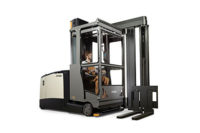Gone are the days when an open-door policy and suggestion box represented the foundations for communication with drivers. According to a survey conducted by the Truckload Carriers Association, Alexandria, Va., and CarriersEdge, Canada, the transportation industry’s best fleets have been continuously working on new ways to keep drivers in the loop and engaged.
This year, fleets continue those efforts with:
Townhalls.
Moving away from the traditional weekly meetings, the most innovative fleets deliver documents and policy updates through interactive townhalls over the web or by satellite. Drivers participate by using a laptop, PC or mobile device or by calling in through a conference line when they don’t have access to the internet. Drivers can also view a full recording of the meeting if they can’t attend during the live session. And, since drivers can view the meeting later, they can stay in the loop and still meet schedules.
Committees.
While driver committees have been around for years, many fleets give their committees mandates, establish processes for keeping work fresh and regularly evaluating their effectiveness. More advanced fleets treat them like town councils by holding elections and even setting term limits. To offer greater transparency, some fleets transmit committee meetings via the web and post minutes on the company’s intranet sites.
Vehicle spec’ing.
Fleets involved in the best fleets program uniformly provide newer, higher-end equipment to drivers, with the average age of their fleets rarely exceeding two years. With much equipment spec’ing to be done, more and more fleets involve drivers through driver committees or by collecting their feedback.
Equipment management.
Regular maintenance beyond the routine oil changes and inspections is just as important as acquiring new gear. That’s why participating fleets have been developing more elaborate communication processes between drivers and shops to gain optimum efficiency. For example, fleets are connecting their trucks’ ECMs to their shop maintenance management systems for increased automation.
Demonstrating respect
Everyone says they respect their drivers. But, since actions speak louder than words, here’s ways to demonstrate respect on a regular basis.
Home time.
Home time is a priority for drivers, particularly during those must-be-there events such as weddings, anniversary celebrations, graduations and birthdays. With drivers on the road so much, companies should implement policies that focus on how accurate they are in getting drivers home on time and then measuring their success.
Recognition.
Moving beyond the traditional annual recognition banquets, some fleets hold events more throughout the year that recognize drivers for safety milestones, driver-of-the-month honors, various anniversaries, positive customer feedback and other accomplishments such as high fuel-efficiency milestones.
Coaching.
Over the past four years, there’s been a shift in driver coaching. Previously, fleets provided coaching and mentoring programs for new hires, or drivers in finishing programs, but only for a short time. Now, the coaching continues for a year or more, and in some cases, never completely stops. Also, with a greater prevalence of dashcams, coaches can use the data to improve their overall effectiveness.
Everyday equality.
Some driver programs can easily be undermined simply by locking drivers out of the building and making them use a driver window to speak to co-workers. They are opening up their terminals, ensuring drivers have the same access as other staffers. HR policies, benefit packages and facilities are also being updated, so drivers receive equal or even preferential treatment.






